
Frequently asked questions regarding PETEC recycling
- Q.1 Please explain the Japanese Home Appliance Recycling Law.
- Q.2 Why can't we just throw away end-of-life home appliances?
- Q.3 How much is the recycling fee?
- Q.4 What is a home appliance recycling coupon?
- Q.5 Is there anything I should be aware of when I hand over home appliances for recycling?
- Q.6 Will manufacturers accept products if I call?
- Q.7 It would be convenient if I could also hand over the TV stand along with the TV for recycling.
- Q.8 Can I bring products directly to the recycling plant since I live near PETEC?
- Q.9 Is it possible to check if the product I disposed of has been recycled?
- Q.10 Does PETEC recycle end-of-life PCs?
- Q.11 Does PETEC recycle small home appliances?
- Q.1
- Please explain the Japanese Home Appliance Recycling Law.
- A.1
-
The Home Appliance Recycling Law stipulates the procedures for recycling end-of-life home appliances. This law took effect on April 1, 2001, for four product categories -- television sets, air conditioners, washing machines and refrigerators -- in order to reduce the volume of disposed home appliances and promote the recycling of resources. The full name of this law is "Law for Recycling of Specified Kinds of Home Appliances." In April 2009, flat-panel TVs and clothes dryers also became subject to the Home Appliance Recycling Law.
For details, go to the page, "Japanese Home Appliance Recycling Law."
For more details on the Japanese Home Appliance Recycling Law, please follow the link below:
Home Appliance Recycling Law (Ministry of the Environment) (Only available in Japanese) - Q.2
- Why can't we just throw away end-of-life home appliances?
- A.2
-
Since it is difficult to incinerate TVs, air conditioners, refrigerators and washing machines discarded from households, most of them were disposed of in landfills. However, there is little space left in the landfill sites, particularly in the Tokyo area and Kinki region. It is estimated that the current landfill sites in those areas will be completely full in several years. Some home appliances contain a large amount of resources. If home appliances are recycled, instead of disposed of, we can recover resources from them and reduce waste at the same time, thus conserving landfill sites.
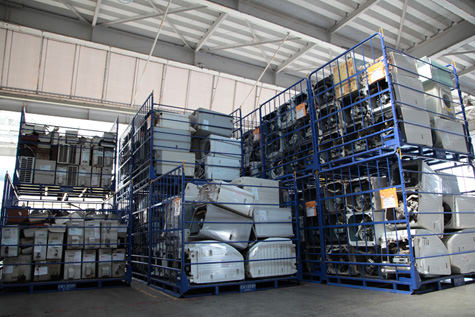
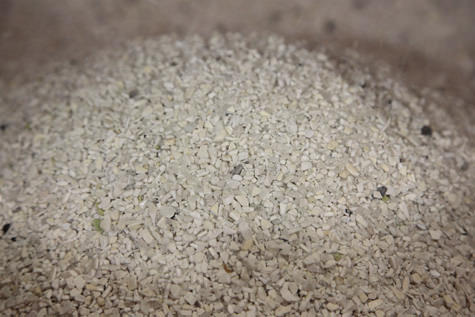
At PETEC, we carefully extract the valuable natural resources that are contained in end-of-life appliances, then return them to material form and give them entirely new roles.
- Q.3
- How much is the recycling fee?
- A.3
-
Regarding the recycling fees charged by manufacturers, please see here.
Website of the List of recycling fees (home appliance recycling fees) (Only available in Japanese) - Q.4
- What is a home appliance recycling coupon?
- A.4
-
The home appliance recycling coupon serves as original data to show that a product has been properly processed, and it helps prevent end-of-life products discarded by consumers from being thrown away during the process. Whenever products are delivered from to the next step, for example, to a retailer, designated collection site, or recycling plant such as PETEC, a copy of the management slip is kept at the site and stored for three years.
For details, go to the page, "Japanese Home Appliance Recycling Law."
- Q.5
- Is there anything I should be aware of when I hand over home appliances for recycling?
- A.5
-
Please check carefully to make sure no items are left in the home appliances before handing them over for recycling. We sometimes find food, garbage, other appliances, etc., in refrigerators and washing machines when they arrive at PETEC.
For details, go to the page, "Japanese Home Appliance Recycling Law."
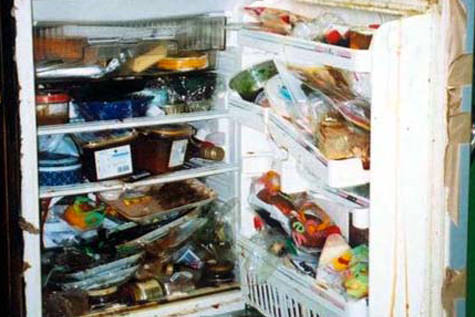
Refrigerator brought to PETEC that contained food
- Q.6
- Will manufacturers accept products if I call?
- A.6
-
To request collection of products, please talk to the retailer from which the goods were purchased, the store from which you are purchasing new products to replace old ones, or the local government if it collects.
For details, go to the page, "Japanese Home Appliance Recycling Law."
- Q.7
- It would be convenient if I could also hand over the TV stand along with the TV for recycling.
- A.7
-
There are only four product categories that fall under the Home Appliance Recycling Law: TVs (flat-panel and CRT), air conditioners, refrigerators/freezers and washing machines/clothes dryers. So, under the law, we cannot handle the recycling of "products other than those four" or "attachments" such as TV stands, outdoor air conditioning unit stands and clothes dryer racks.
For details, go to the page, "Japanese Home Appliance Recycling Law."
- Q.8
- Can I bring products directly to the recycling plant since I live near PETEC?
- A.8
-
For the collection of an end-of-life home appliance, please contact the retail store where you purchased that product. If you are purchasing a new product to replace the old one, the store will take the old product. If you are moving, the local government will take the product. (Since some local governments do not accept home appliances for recycling, you need to consult with the nearest local government.)
For details, go to the page, "Japanese Home Appliance Recycling Law."
- Q.9
- Is it possible to check if the product I disposed of has been recycled?
- A.9
-
If you enter the recycling number on the website of the Home Appliance Recycling Coupon Center (Association for Electric Home Appliances), you can check (Only available in Japanese). You may also call the retailer to which you handed over the product. The store can trace the product from the copy of the management slip.
- Q.10
- Does PETEC recycle end-of-life PCs?
- A.10
-
PETEC recycles only designated home appliances. Since recycling of PCs is regulated by a different law, we do not handle PCs.
For details, go to the page, "Sustainability Initiatives – Corporate Computer Solutions – Panasonic Connect." (Only available in Japanese)
- Q.11
- Does PETEC recycle small home appliances?
- A.11
-
PETEC recycles only designated home appliances. Since recycling of small home appliances is regulated by a different law, we do not handle them.
For details, go to the page, "About Recycling of Small Home Appliances (Ministry of the Environment)." (Only available in Japanese)
- Q.1 From where do home appliances for recycling come to PETEC?
- Q.2 Does PETEC recycle only Panasonic products?
- Q.3 How many products does PETEC recycle?
- Q.4 What is the recycling rate?
- Q.5 What makes PETEC different from other recycling plants?
- Q.6 What technologies and methods were developed originally by PETEC?
- Q.7 How are materials sorted?
- Q.8 How does PETEC process recover fluorocarbons?
- Q.9 Are there products that are made of materials recycled at PETEC?
- Q.10 What happens to the waste that cannot be recycled?
- Q.11 What kind of measures does PETEC take to conserve the local environment?
- Q.12 Can we tour the plant?
- Q.13 What can we see on the plant tour?
- Q.1
- From where do home appliances for recycling come to PETEC?
- A.1
-
Based on the Home Appliance Recycling Law enacted in April 2001, PETEC recycles products that are manufactured by Group A companies (see Q.2) and collected after use by retailers and gathered at "designated collection points" in the Kinki region's six prefectures.
For details, go to the page, "Japanese Home Appliance Recycling Law."
- Q.2
- Does PETEC recycle only Panasonic products?
- A.2
-
PETEC also recycles products of other manufacturers. Home appliance manufacturers (including importers) are divided into two groups: Group A and Group B. PETEC recycles products manufactured by Group A (20 companies including Panasonic, Toshiba, Victor Company of Japan, Daikin Industries, Tokyo Gas, Osaka Gas, Corona and LG Electronics, as of July 2014, FY2013 Annual Report).
List of designated collection points
Website of the Home Appliance Recycling Coupon Center, Association for Electric Home Appliances (Only available in Japanese) - Q.3
- How many products does PETEC recycle?
- A.3
-
PETEC processes approximately 700,000 to 800,000 units of TVs, air conditioners, refrigerators/freezers and washing machines annually. The cumulative number of units recycled by PETEC reached 10 million units in July 2013, and 18 million units in December 2022.
Related News:
The Cumulative Number of End-of-life Home Appliances Recycled Reached 10 Million. - Q.4
- What is the recycling rate?
- A.4
-
The recycling rate is the percentage of valuable materials recovered from end-of-life products. The Home Appliance Recycling Law stipulates a minimum recycling rate of 74% for flat-panel TVs, 55% for CRT TVs, 80% for air conditioners, 70% for refrigerators, and 82% for washing machines/clothes dryers. At PETEC, where our goal is "product to product," we are able to maintain recycling rates that are higher than those prescribed by the law as well as the nationwide averages by using technologies to split the CRTs of TVs, separate copper and aluminum at high purity from heat exchangers, and sort mixed plastics.
For details, go to the page, "Recycling Processes."
- Q.5
- What makes PETEC different from other recycling plants?
- A.5
-
There are five recycling lines at PETEC, and we are striving for zero waste by developing recycling technologies for each product category.
We also have an R&D Division on the plant premises, which passes on research results to enable manufacturing of products that are easier to recycle. From the construction stage, the plant was designed as "a facility that could accommodate tours," and the tour route is located on the second floor for the visitors' safety. The facility is used as an environmental education site for groups of elementary and junior high school students and as a training site for employees of Panasonic and other companies.For details, go to the page, "Factory Tours."
- Q.6
- What technologies and methods were developed originally by PETEC?
- A.6
-
PETEC conducted research for three years even before the plant started operation, and applied for various patents. We were the first to introduce and put into practice technologies and methods for rapidly splitting CRTs, crushing compressors at ordinary temperatures, separating copper and aluminum at high purity from heat exchangers, and sorting and separating mixed plastics into single-component resins.
For details, go to the page, "Recycling Technology Development."
- Q.7
- How are materials sorted?
- A.7
-
After products are finely crushed, we use various technologies and special machines for accurate sorting based on their characteristics such as specific gravity. Those technologies and machines utilize the force of air, magnetic force, eddy current and sink-float density separation.
Air conditioners are dismantled block by block according to the type of material, then processed. TV CRTs are removed from TV sets by hand, then crushed, cleaned and sized in soundproof rooms.For details, go to the page, "Recycling Processes."
- Q.8
- How does PETEC process recover fluorocarbons?
- A.8
-
PETEC recovers fluorocarbons used as a refrigerant in air conditioners, refrigerators and some washing machines. The recovered fluorocarbons are sealed in cylinders and handed over to a fluorocarbon processing company for detoxification. During the refrigerator recycling process, insulation is crushed in a sealed room and then the fluorocarbons used in the foam insulation are adsorbed by activated charcoal in order to prevent fluorocarbons from being discharged into the environment. The recovered fluorocarbons are sealed in drums and delivered to a fluorocarbon processing company for detoxification.
For details, go to the page, "Recycling Processe."
- Q.9
- Are there products that are made of materials recycled at PETEC?
- A.9
-
Yes. For example, the glass recovered from TV CRTs is used to manufacture new glass for new CRTs. The plastics recycled from washing machines are reused to produce bottom frames of washing machines, and the plastics from refrigerators are reused to manufacture refrigerator components. In recent years, increased amounts of recycled plastics are sent to other plants and used to manufacture new home appliances.
For details, go to the page, "Recycling Processes."
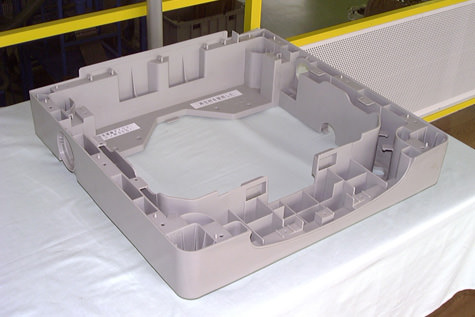
Bottom frame of a washing machine made from PP resin recycled from end-of-life washing machines
- Q.10
- What happens to the waste that cannot be recycled?
- A.10
-
PETEC specializes in the recovery of recyclable materials.
We outsource the processing of waste that cannot be recycled to specialized companies for proper processing. - Q.11
- What kind of measures does PETEC take to conserve the local environment?
- A.11
-
Since soundproof rooms and vibration-damping equipment are used at our plant, no noise problems are generated by the operation of the plant.
Dust collecting equipment is installed in the plant so that a clean environment is maintained. The recycled materials are sorted by type and stored in a warehouse. Drainage water is passed through a water processor before being released into the sewage system.
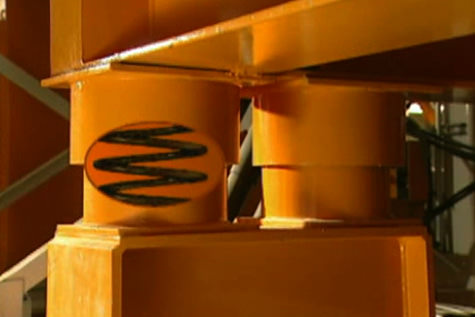
Vibration-damping equipment
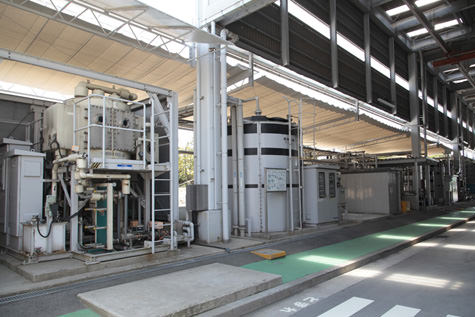
Sewage system
-
Moreover, we have established an Environmental Conservation Committee together with local residents and regularly exchange ideas with them.
For details, go to the page, "Social and Environmental Responsibility."
- Q.12
- Can we tour the plant?
- A.12
-
Yes. Please make a reservation. We offer tours for adults and for children.(Tours are available only in Japanese.)
For details, go to the page, "Factory Tours."
- Q.13
- What can we see on the plant tour?
- A.13
-
After the guidance and DVD viewing, we will show you a display of various items and the recycling lines.
For details, go to the page, "Factory Tours."
















